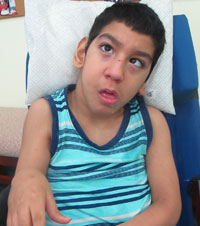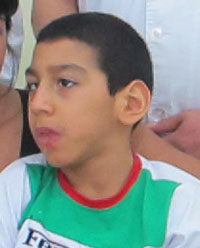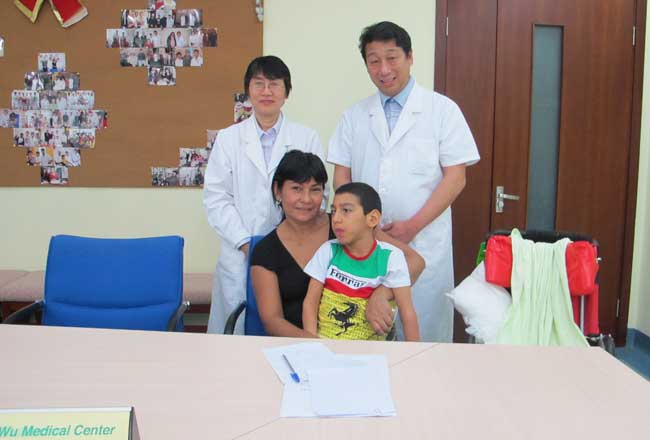Pablo - Cerebral palsy (Argentina) Update on Aug. 4, 2015
 The second round treatment:
The second round treatment:
Name: Pablo Marcelo Piedrabuena
Sex: Male
Country: Argentina
Age: 11 years
Diagnosis: 1.Cerebral palsy 2. Secondary Epilepsy 3. Upper Respiratory Tract Infection(cured)
Date of Admission: June 22th, 2015
Treatment Hospital/Period: Wu Medical Center/26 days
Before treatment:
The patient is a premature baby and was born through cesarean. The patient suffered from frequent epileptic seizure due to oxygen deprivation during birth. He received anti-epileptic therapy in a local hospital. About 15 days later, the patient's disease was under control. But his growth and development was limited. He also suffered from severe delay in movement and cognitive function. From onset of the disease, the patient managed with spasmolysis and tranquilizer medications for a long time. He received rehabilitation in a local rehabilitation school. He came to our center 1 year ago and after the treatment, he became better. His muscle tension was better. He could turn his head and trunk better. He could sit for awhile. His spirit was better and cognitive function was better. He began having interest in things. He didn’t experience epileptic seizure during those days. He took Tizanidina 4mg every night. He couldn’t speak. He had dyscinesia and cognitive disorder. He couldn’t turn over his body or walk. His family wanted a better life for him, so he came to our medical center again and he diagnosed with cerebral palsy.
His spirit was bad, he had difficult to swallow food, so he was fed using fistula. His sleep was good. He had constipation and wore paper diaper. The urine volume and color were normal.
Admission PE:
Bp: 126/80mmHg. Hr: 120/min. Body temperature: 37.0 degree. Weight: 22kgs. Height:125 cm. The thorax had mild extroversion. The respiratory sounds in both lungs were hoarse, there was some gurgling with sputum. There were many sputum and secretions in his throat. The cardiac rhythm of his heart was regular, with no obvious murmur in the valves. Tension in the abdominal muscle. The liver and spleen were normal. Both lower limbs were normal.
Nervous System Examination:
Pablo Marcelo Piedrabuena was alert. He couldn’t speak, he could only phonate. He couldn’t communicate with others. His reaction time was slowly. Both pupils were equal in size and round, both pupils were sensitive to light stimulus. The eye position was abnormal. The eyeballs movement was flexible. There was nystagmus. He couldn’t cooperate with tongue examination. His uvula was in the center of oral. He had difficult to swallow. The muscle of his neck was tense. His head always tilted to the right, he could turn his head to left. The tension of neck was a little higher. The muscle tension of his four limbs was higher after he was upset, sleeping or quiet. He couldn’t cooperate with muscle power examination. He could sit with other’s help. He could extend his spinal column. When he sat, his lower limbs were pendulous. The abdominal reflex was abnormal, both side tender reflex was over active. The sucking reflex was positive. Both side palm jaw reflex was negative. Bilateral Hoffmann sign and Babinski sign were negative. He couldn’t cooperate with other examination.
Treatment:
After admission, the patient diagnosed as cerebral palsy and secondary epilepsy, he received treatment to initiate his nerve repair and regeneration. He had four times of stem cell injection including neural stem cells and mesenchymal stem cells. He had treatment to activate his endogenous retinal stem cells, improve circulation, nourish nerves and adjust immune system. This was accompanied with rehab training. The patient had upper respiratory tract infection during his stay in our hospital, so he received treatment to diminish inflammation, reduce phlegm and improve his immunity.
Post-treatment:
After treatment, his infection has been controlled. His understanding and reaction were better. He could speak more words. His ability to swallow was better, he could eat some semi-liquid diet. He had more facial communication with his family members. His upper limbs were more flexible than before. His left hand could wave and had slight grip movement. The sound in his throat has reduced. He could control his back and neck muscle better. The muscle tension of four limbs was lower. He has not experienced epilepsy seizure or spasm.
The first round treatment:
Name:Pablo Marcelo Piedrabuena 
Sex: Male
Country: Argentina
Age: 10 years
Diagnoses:Cerebral palsy
Date:April 14, 2014
Days Admitted to Hospital: 28 days
Before treatment:
The patient is a premature baby and born through cesarean. The patient suffered from frequently epileptic seizure for oxygen deprivation during his birth process. He received anti-epileptic therapy in a local hospital. About 15 days later, the patient's disease was under control. But his growth and development was limited. He also suffered from severe delay in movement and cognitive function. From onset of the disease, the patient took spasmolysis and tranquilizer medications for a long time. He received rehabilitation in a local rehabilitation school. Before the treatment, the patient still had epileptic seizure. He had no speech disorder. He also suffered from cognitive disorder. He couldn't turn over, sit or walk. He was kept in bed. The trunk was presented with torsion-spasm.
From onset of the disease, the patient had poor spirit. He had swallowing difficulty. He had diet through gastrointestinal colostomy and feeds 8 times each day. The sleep was ok. He had constipation and used paper diaper for urine. The urine quality and color was almost normal.
Admission PE:
BP: 110/65mmHg, HB: 99/min, Temperature: 36.5 degree, Weight: 20kg. The thorax was slightly out of shape. The respiratory sounds in both lungs were clear with no signs of dry or moist rales. He had very clear stridor and sometimes has phlegm or other matter in his mouth. The rhythm of heartbeats was regular without obvious murmur in the valves. His abdominal muscles had tension. The liver and spleen were normal with palpable touch. His legs were not swollen.
Nervous System Examination:
The patient was alert. He could say some syllables, but could not speak or communicate with others. He was slow in response. He could not cooperate with memory, orientation and calculation test. Both pupils were equal in size and round. He could make some sounds but could not speak or communicate. He was slow in reaction. His eyes were flexible to light stimulus. His eyes were not in right position and has nystagmus. He could not cooperate to tongue protrusion. The uvula was in the middle. The tonsil was enlarged and he has difficulty in swallowing. His neck muscle had tension. His head tends to turn to right side due to spasticity. He had difficulty in raising his head. The muscle tone of his arms and legs was higher than normal. His right arm was in flexed posture and his lower limbs were in a straightened posture. He could not cooperate with the exam of muscle strength. His body trunk was weak, and he could not turn over, sit-up or walk. His bilateral abdominal reflex was negative. Bilateral tendon reflex was active. Bilateral ankle clonus reflex was negative. Sucking reflex was positive. Bilateral jaw reflex and Babinski sign were negative. He could not cooperate with other examinations. The laboratory test showed he had abnormal liver function. The glutamic-pyruvic transaminase level was higher than normal.
Treatment:
After admission, the patient was diagnosed with cerebral palsy and secondary epilepsy and abnormal liver function. He received treatment for nerve regeneration and to activate stem cells in the body. He was given treatment to improve the blood circulation in order to increase the blood supply to the damaged nerves and nourishment for the neurons. He was also given treatment to protect his liver and alleviate the tension of his body. This was combined with daily physical rehabilitation therapy.
Post-treatment:
The seizure has been under control. The liver function has improved and the level has reach the normal level. He has more facial expression. He has emotional communication with others. The stridor sound is lower than the time he was admitted. The muscle tone of his head, neck and limbs has been alleviated. He can turn to left side more flexibly and keeps a longer time than before. The torsion-spasm in the whole body is alleviated. The movement of his four limbs has increased. He can turn over partly.

(Download the Windows Media Player Firefox Plugin if you are using Firefox browser.
To know more,Please read Using the Windows Media Player plugin with Firefox.)
